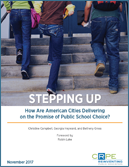Read the Executive Summary or the full Analysis. Explore individual City Reports.
Public school choice is increasingly the “new normal” in cities across the country, creating new opportunities for families to choose from a wider variety of instructional models across a range of school types—from traditional district-run to magnet to charter. But how well are cities delivering on the real promise of school choice, that is, ensuring that all children have access to high-quality educational options that fit their needs?
To better understand how public school choice is working for families, CRPE researchers looked across performance outcomes and system reforms in 18 “high-choice” cities—those with both a robust charter sector and district strategies that provide students options beyond traditional enrollment boundaries.

As part of this analysis, CRPE has developed an online resource that provides a Citywide Education Progress Report for each of the 18 cities, enables visitors to compare cities by their outcomes and system reforms, gives detailed background on the methodology informing the project, and more. The data was updated in June 2018.

Our questions for the 18 cities
For these cities, each of which offers public school choice to families and holds its schools accountable for meeting performance standards, we asked the following questions:
• Is the education system continuously improving?
• Do all students have access to a high-quality education?
• Is the education strategy rooted in the community?
Challenges facing high-choice cities
The report not only rates the cities for their performance on continuous improvement, equitable access, and community engagement, but also defines three challenges these cities face:
• Improving how families are informed of their public school choices
• Being more strategic about the city’s school portfolio, so models meet children’s needs and families’ preferences for schools in their neighborhoods
• Involving community members to be part of building a sustainable, responsible education strategy
Recommendations to address these challenges
To keep improving their school choice systems, city leaders should move beyond early successes and work collaboratively across sectors to address persistent, citywide issues such as inequitable access. They should also move away from scattershot initiatives and pursue more targeted efforts that are coordinated, data-driven, and transparent.
This project builds on our 2015 report, Measuring Up: Educational Improvement and Opportunity in 50 Cities. While that report measured outcomes based on test scores and non-test indicators, this analysis offers a deeper look at policy, implementation, and outcomes within a subset of cities.







